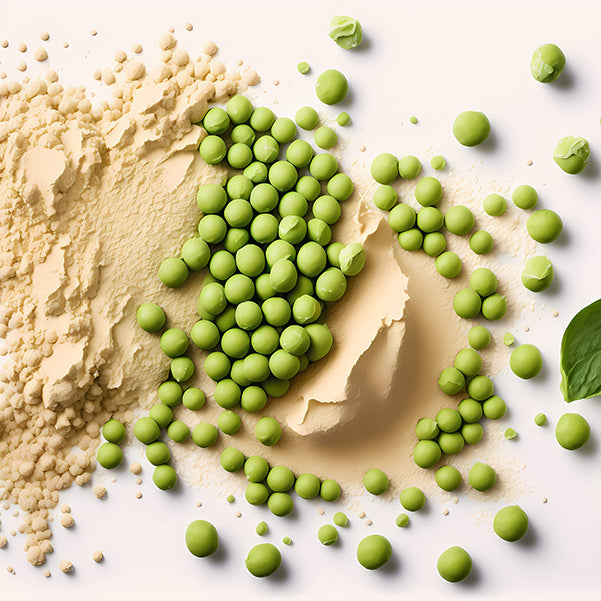Anti-Nutrients in Pea Protein Powder?

Share
WHAT ARE ANTI-NUTRIENTS AND WHY THEY GET SUCH A BAD REPUTATION?
Anti-nutrients are naturally occurring substances in certain foods that interfere with the absorption of essential nutrients such as proteins, vitamins, and minerals. Some common anti-nutrients include lectins, phytates, and tannins.
Lectins are proteins that bind to carbohydrates and can cause digestive problems and inflammation in sensitive individuals[1]. Phytates, found in grains and legumes, can bind to minerals such as iron, zinc, and calcium and reduce their absorption. Tannins, found in some teas, wines, and nuts, can bind to proteins and enzymes and decrease their availability.
Anti-nutrients can bind to the digestive tract's lining cells as well. This could interfere with nutrient digestion and absorption and have an impact on the development and function of intestinal flora. Lectin proteins are thought to contribute to inflammatory diseases including rheumatoid arthritis and type 1 diabetes because they adhere to cells for extended periods of time and may trigger an autoimmune reaction. [2],[3]
These ideas have helped to fuel the lucrative anti-lectin movement, which has resulted in best-selling books and enzyme supplements to stop lectin activity in the body. However, there is very limited research in humans on the amount of active lectins consumed in the diet and their long-term health effects. Anti-nutrients including lectins are most often studied in the diets of developing countries where malnutrition is prevalent, or where food variety is very limited and whole grains and legumes are important daily staples. [4],[5]
It's crucial to keep in mind that consuming meals high in active anti-nutrients is uncommon. One explanation is that anti-nutrients are only active when the foods are raw, but most foods that contain them are not consumed uncooked. Most anti-nutrients are deactivated by cooking, especially moist high-heat techniques like boiling or stewing or prolonged soaking in water. [6] Anti-nutrients are water-soluble and often present on the outside of foods, such as beans and wheat grains; therefore, they can be eliminated by washing, or by physically removing the outer hull.
WHY YOU NEED NOT TO WORRY ABOUT ANTI-NUTRIENTS IN YOUR SOLO PEA PROTEIN POWDER?
Anti-nutrients in peas such as lectins, phytates (phytic acids), and trypsin inhibitors are heat sensitive, water soluble, and mostly found in the outer hull of peas.
Field Peas grown in farms are allowed to dry in the pods before harvest. Sun-dried field peas then undergo milling, a mechanical action to remove the outer shells. Because anti-nutrients are mostly found in the outer hull of peas, the milling mechanically removes the majority of anti-nutrients by removing the outer shells. The result is a flour containing soluble fibers, starches and proteins.
The flour is then subjected to wet filtration with dilute salt solution as the extracting agent. Because anti-nutrients are water soluble, when the pea flour is soaked in water, any remnants of anti-nutrients left in the dehulled peas readily dissolve into the water. The long exposure to water during the wet filtration further removes any remnant of anti-nutrients from the pea solids.
The solution is then boiled in high temperature. Since anti-nutrients are heat sensitive, the high temperature effectively deactivates them. Lastly, pea protein is precipitated out from the solution at its isoelectric point and then freeze dried. The result is pea protein isolate with virtually no phytic acid content.
The extraction process of pea proteins effectively eliminates anti-nutrients from peas.
References:
[1] Peumans WJ, Van Damme EJ. Lectins as plant defense proteins. Plant physiology. 1995 Oct;109(2):347.
[2] Vasconcelos IM, Oliveira JT. Antinutritional properties of plant lectins. Toxicon. 2004 Sep 15;44(4):385-403.
[3] Freed, DLJ. Do dietary lectins cause disease? The evidence is suggestive—and raises interesting possibilities for treatment. BMJ. 1999 Apr 17; 318(7190): 1023–1024.
[4] Gibson RS, Bailey KB, Gibbs M, Ferguson EL. A review of phytate, iron, zinc, and calcium concentrations in plant-based complementary foods used in low-income countries and implications for bioavailability. Food Nutr Bull. 2010 Jun;31(2 Suppl):S134-46.
[5] Roos N, Sørensen JC, Sørensen H, Rasmussen SK, Briend A, Yang Z, Huffman SL. Screening for anti-nutritional compounds in complementary foods and food aid products for infants and young children. Matern Child Nutr. 2013 Jan;9 Suppl 1:47-71.
[6] Petroski W, Minich DM. Is There Such a Thing as “Anti-Nutrients”? A Narrative Review of Perceived Problematic Plant Compounds. Nutrients. 2020 Oct;12(10):2929.



1 comment
Thank you for clearing the air about “anti-nutrients”, lectins and pea powder. This was a great article.
I am really frustrated with people like Dr. Steven Gundry, who has long ads everywhere, loaded with false accusations and scare tactics, about plant proteins like pea and brown rice proteins, saying they are “toxic plants” that cause obesity and disease. That’s simply not true.
Plant protein powders in food can help people rely less or completely avoid animal products, and are much more sustainable to grow and produce for populations. Gundry’s spreading fear and confusion just to make a buck. He should be shut down. As a medical doctor, he knows how to honestly interpret research, and yet he makes foolish claims- like extrapolating from cell studies to human causes. He also has to have studied ethics as a physician. I am disgusted by him.